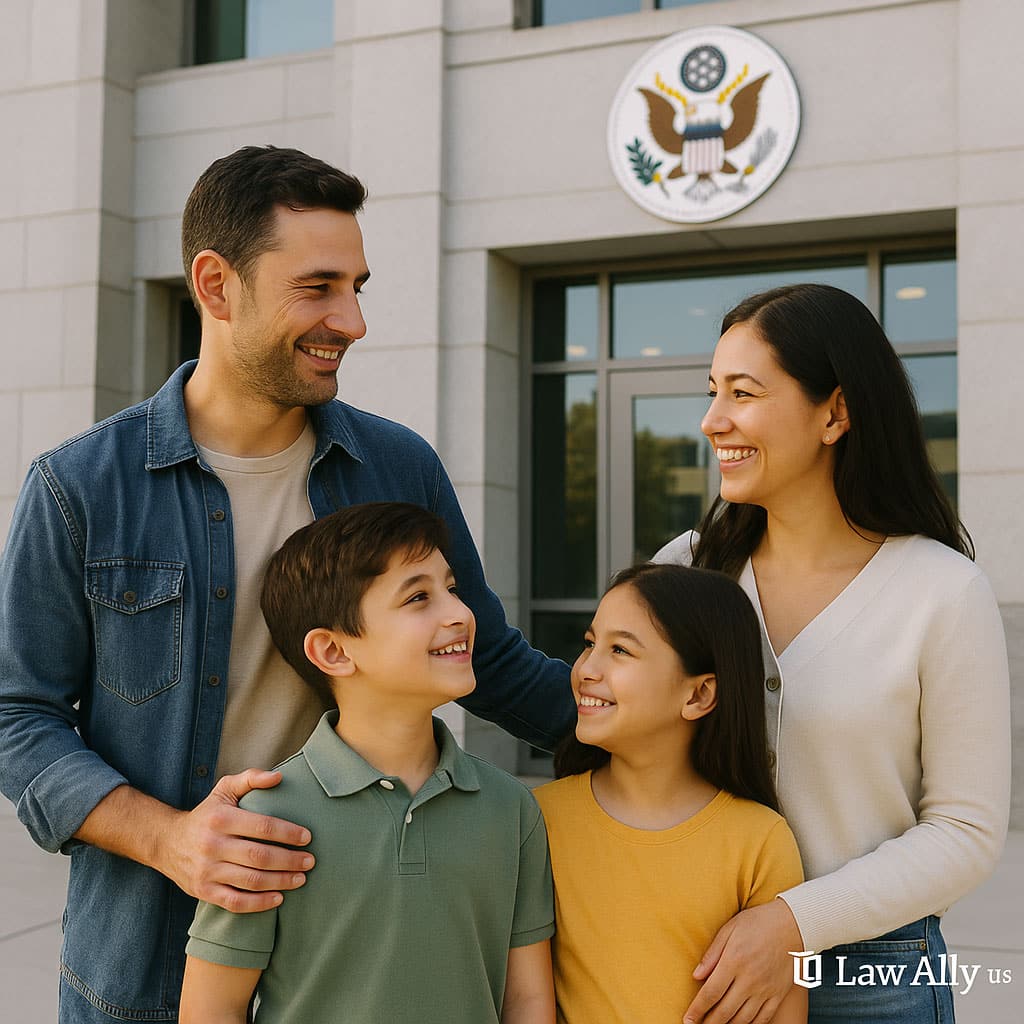For many immigrants, the I-130 Petition for Alien Relative represents more than just paperwork, it is the key that opens the door to family unity in the United States. Whether you are an immigration attorney, a paralegal handling petitions daily, or an immigrant preparing your own case, understanding how to complete this form correctly is essential.
At Law Ally US, we know that every family story carries both legal and emotional weight. With years of experience teaching attorneys, paralegals, and aspiring legal professionals, we have seen how mastering the I-130 can transform the way you serve clients, or even your own loved ones. This article will walk you through the essentials of filing Form I-130, highlight common pitfalls to avoid, and show you resources that make the process more manageable.
What is Form I-130 and Who Can File It?
Form I-130, officially known as the Petition for Alien Relative, is used by U.S. citizens and lawful permanent residents (green card holders) to establish a qualifying family relationship with a relative who wishes to immigrate to the United States.
Eligible petitioners include:
- U.S. citizens filing for spouses, unmarried or married children, parents, or siblings.
- Lawful permanent residents filing for spouses and unmarried children.
Filing Form I-130 is not the same as granting permanent residence. Instead, it confirms that the relationship is valid in the eyes of U.S. immigration law and allows the relative to move forward with the green card process through either Adjustment of Status or Consular Processing.
👉 If you want to go beyond the basics and learn step-by-step how to prepare and file this petition, our I-130 training inside the Family Course Bundle provides guided instruction with real examples.
Key Steps in Preparing Form I-130
Filing Form I-130 requires more than just filling out blanks, it’s about presenting a complete and well-documented petition that demonstrates a valid family relationship. The key steps are:
- Confirm eligibility – Make sure the petitioner is a U.S. citizen or lawful permanent resident and that the family relationship is covered under immigration law.
- Gather evidence – Collect birth certificates, marriage certificates, or other official records that prove the qualifying relationship.
- Complete the form accurately – Provide consistent information across all sections, especially names, dates, and addresses.
- Pay the filing fee – Submit the correct payment based on USCIS requirements.
- File online or by mail – Most petitioners can now file Form I-130 online, but mail filing is still an option.
- Wait for receipt notice – Once accepted, USCIS issues Form I-797 (Notice of Action) confirming the petition has been received.
👉 To build confidence in every step, from gathering the right documents to filing online, our Family Course Bundle offers practical guidance and real-world examples tailored for attorneys, paralegals, and immigrants.
Common Mistakes to Avoid When Filing Form I-130
Even small errors can delay or jeopardize an I-130 petition. Some of the most common mistakes include:
- Missing signatures – Unsigned forms are automatically rejected.
- Incomplete sections – Leaving blank answers in critical parts, such as family history, can result in rejection or requests for evidence.
- Insufficient evidence – Submitting vague or inadequate documentation to prove the relationship.
- Inconsistent information – Dates, names, or addresses that don’t match across forms or supporting records.
- Incorrect filing fee – Payment errors are a frequent cause of delays.
- Forgetting translations – Any document not in English must include a certified translation.
Avoiding these pitfalls requires attention to detail and familiarity with USCIS standards.
👉 To better understand how to avoid costly mistakes, our I-130 petition training inside the Family Course Bundle breaks down real examples and shows you exactly what USCIS looks for in each submission.
What Happens After USCIS Approves Form I-130?
An approved I-130 petition does not immediately grant permanent residence. Instead, it confirms that the family relationship is valid under U.S. immigration law. The next step depends on where the relative is located:
- Inside the United States (Adjustment of Status) – If the relative is already in the U.S. and a visa number is available, they may file Form I-485 to adjust status to permanent resident.
- Outside the United States (Consular Processing) – If the relative is abroad, the case is forwarded to the National Visa Center (NVC) and then to a U.S. consulate or embassy for immigrant visa processing.
Timelines vary based on family preference categories, country of origin, and visa availability. Checking the Visa Bulletin regularly is essential to understand waiting times.
👉 Understanding the approval is only the beginning. To master both the I-130 and the next steps, whether Adjustment of Status or Consular Processing, our Family Course Bundle walks you through the entire process with guided examples.
Supporting Documents Checklist
The strength of an I-130 petition often depends on the supporting evidence provided. While the exact documents vary by relationship, the following checklist covers the most common requirements:
| Relationship | Required Documents | Additional Evidence |
| Spouse | Marriage certificate, proof of termination of prior marriages (if any) | Joint lease, joint bank accounts, photos, affidavits |
| Parent | Petitioner’s birth certificate showing parent’s name | Proof of petitioner’s U.S. citizenship or residency |
| Child under 21 (unmarried) | Child’s birth certificate listing both parents | Evidence of legal custody or legitimation if applicable |
| Married or adult child | Birth certificate | Proof of petitioner’s U.S. citizenship (only citizens can petition) |
| Sibling | Petitioner’s and sibling’s birth certificates showing a common parent | Evidence of petitioner’s U.S. citizenship |
Submitting organized, complete, and consistent documentation helps avoid delays and requests for evidence (RFEs).
👉 If you want guided checklists, sample documents, and step-by-step practice, our Family Course Bundle provides the tools attorneys, paralegals, and immigrants need to file stronger petitions.
Why Immigration Law Professionals (and Paralegals) Should Master Form I-130
For attorneys and paralegals, mastering the I-130 is not just about handling a single form, it’s about building trust with clients and ensuring their cases move forward without unnecessary delays. Because the I-130 is often the first step in many family-based immigration processes, errors at this stage can create long-lasting consequences.
Professionals who are well-trained in completing I-130 petitions can:
- Deliver faster, more accurate results for clients.
- Reduce the risk of RFEs and denials.
- Build credibility and reputation within their practice.
- Train legal support staff more effectively.
Even for immigrants preparing their own petitions, understanding the I-130 thoroughly can mean the difference between approval and rejection.
👉 To gain practical experience and boost your professional skills, our Family Course Bundle is designed to help attorneys, paralegals, and immigrants handle I-130 petitions with confidence.
Learn How to Prepare I-130 Petitions Step by Step
While guides and checklists are useful, nothing compares to structured, hands-on training that shows you exactly how to complete Form I-130 from start to finish. A step-by-step approach ensures you not only understand the requirements but also gain the confidence to apply them in real cases.
That’s why we created the Family Course Bundle, a comprehensive program designed for attorneys, paralegals, and even immigrants who want to learn the process the right way. Inside the bundle, you’ll find:
- Detailed walkthroughs of the I-130 petition.
- Practical examples of supporting evidence.
- Tips to avoid common mistakes.
- Guidance on next steps, including Consular Processing.
👉 Get started today with our step-by-step I-130 petition training in the Family Course Bundle and build the skills you need to prepare stronger, more reliable family petitions.
Take the Next Step in Mastering Family Petitions
Preparing an I-130 petition is more than just filling out a form, it’s about understanding the law, avoiding mistakes, and presenting a strong case that helps families reunite. Whether you are a legal professional or an immigrant handling your own petition, having the right guidance makes all the difference.
👉 If you’re ready to gain hands-on skills in preparing I-130 and other family petitions, explore our Family Course Bundle. It’s designed to give attorneys, paralegals, and immigrants the confidence and practical tools to succeed in family-based immigration cases.
Frequently Asked Questions About Form I-130
- What documents do I need for Form I-130?
You need proof of the qualifying family relationship, such as birth or marriage certificates, plus proof of U.S. citizenship or permanent residence. Additional evidence like joint financial records or photos may be required for spousal petitions. - Can I file Form I-130 online?
Yes. Most petitioners can file online through the USCIS website. However, some cases, such as certain petitions filed from abroad, must be filed by mail. - How long does it take for I-130 to be approved?
Processing times vary depending on the type of relationship and the petitioner’s status (U.S. citizen vs. permanent resident). On average, it can take several months to more than a year. Checking USCIS’s current processing times is recommended.
4. Do I need an attorney to file I-130?
It is not required, but many petitioners benefit from professional guidance. Attorneys and paralegals can help avoid mistakes, and immigrants can also learn the process step by step through resources like our Family Course Bundle.




